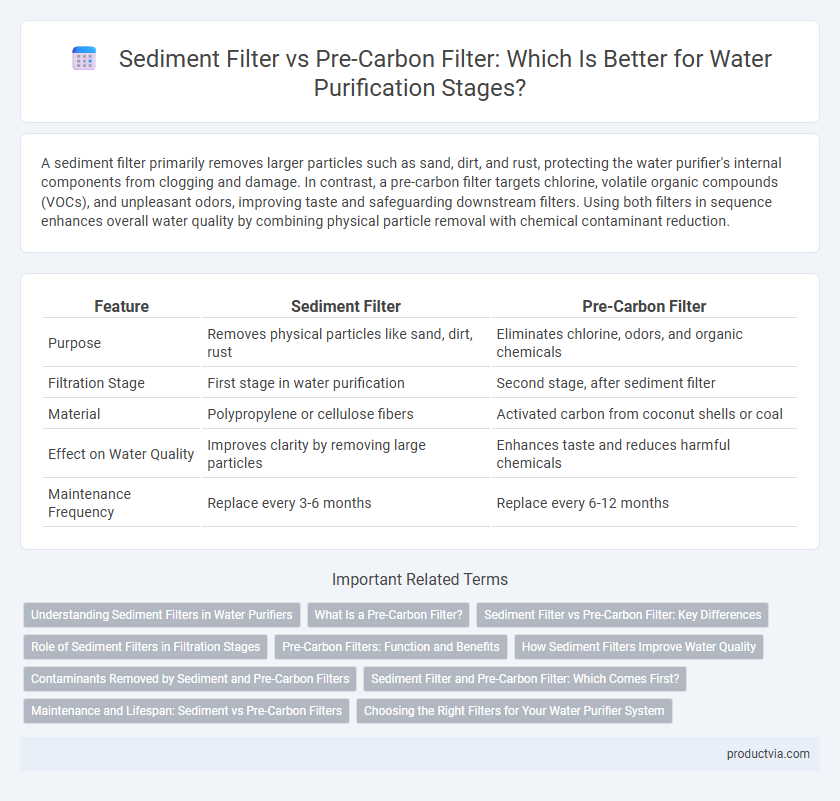A sediment filter primarily removes larger particles such as sand, dirt, and rust, protecting the water purifier's internal components from clogging and damage. In contrast, a pre-carbon filter targets chlorine, volatile organic compounds (VOCs), and unpleasant odors, improving taste and safeguarding downstream filters. Using both filters in sequence enhances overall water quality by combining physical particle removal with chemical contaminant reduction.
Table of Comparison
| Feature | Sediment Filter | Pre-Carbon Filter |
|---|---|---|
| Purpose | Removes physical particles like sand, dirt, rust | Eliminates chlorine, odors, and organic chemicals |
| Filtration Stage | First stage in water purification | Second stage, after sediment filter |
| Material | Polypropylene or cellulose fibers | Activated carbon from coconut shells or coal |
| Effect on Water Quality | Improves clarity by removing large particles | Enhances taste and reduces harmful chemicals |
| Maintenance Frequency | Replace every 3-6 months | Replace every 6-12 months |
Understanding Sediment Filters in Water Purifiers
Sediment filters in water purifiers are designed to remove large particles such as sand, dirt, and rust from the water, protecting downstream filtration stages and extending their lifespan. Unlike pre-carbon filters that primarily target chlorine, odors, and organic compounds, sediment filters focus on physical contaminants to improve water clarity. These filters typically use materials like pleated polyester or polypropylene to capture particles as small as 5 microns, making them essential for maintaining overall water quality in multi-stage purification systems.
What Is a Pre-Carbon Filter?
A pre-carbon filter is an essential stage in water purification that uses activated carbon to reduce chlorine, volatile organic compounds (VOCs), and unpleasant odors from the water. Unlike sediment filters that primarily remove larger particles such as sand, dirt, and rust, pre-carbon filters target chemical contaminants, improving taste and protecting subsequent filtration stages like reverse osmosis membranes. This filtration process enhances overall water quality by eliminating harmful substances before final purification.
Sediment Filter vs Pre-Carbon Filter: Key Differences
Sediment filters primarily remove large particles such as sand, dirt, and rust from water, preventing clogging in subsequent filtration stages. Pre-carbon filters target chlorine, volatile organic compounds (VOCs), and unpleasant odors, improving taste and protecting sensitive membranes like RO or UF membranes. Understanding these differences helps optimize multi-stage water purification systems for enhanced water quality and filter longevity.
Role of Sediment Filters in Filtration Stages
Sediment filters play a critical role in the initial stage of water purification by removing large particles such as sand, dirt, and rust that can damage subsequent filtration components. These filters protect pre-carbon filters by preventing clogging and extending their lifespan, ensuring more effective removal of chlorine, odors, and organic compounds. By maintaining the efficiency of advanced filtration stages, sediment filters contribute to overall improved water quality and system durability.
Pre-Carbon Filters: Function and Benefits
Pre-carbon filters are critical in water purification, effectively reducing chlorine, volatile organic compounds (VOCs), and unpleasant odors that affect taste and safety. These filters improve water quality by protecting subsequent filtration stages from chemical damage and enhancing overall purifier efficiency. Their adsorption properties extend the lifespan of reverse osmosis membranes and other delicate components, making pre-carbon filters indispensable in multi-stage filtration systems.
How Sediment Filters Improve Water Quality
Sediment filters improve water quality by removing large particles such as sand, dirt, rust, and other debris from the water, preventing clogging and damage to subsequent filtration stages. These filters serve as the first line of defense, enhancing the efficiency and lifespan of pre-carbon filters by ensuring they are not blocked by physical impurities. By effectively reducing sediment, they contribute to clearer, cleaner water and protect the overall purification system.
Contaminants Removed by Sediment and Pre-Carbon Filters
Sediment filters effectively remove physical particles such as sand, dirt, rust, and silt from water, protecting downstream components and improving water clarity. Pre-carbon filters target chemical contaminants, reducing chlorine, volatile organic compounds (VOCs), pesticides, and unpleasant tastes and odors. Combining both filtration stages ensures comprehensive removal of both particulate matter and harmful chemicals for safer, cleaner drinking water.
Sediment Filter and Pre-Carbon Filter: Which Comes First?
A sediment filter captures large particles like sand, dirt, and rust, preventing clogging in subsequent stages, so it is installed first in the water purification process. The pre-carbon filter follows, targeting chlorine, odors, and organic compounds to improve taste and protect downstream filters. Proper sequencing ensures optimal filtration efficiency and extends the lifespan of advanced purification components.
Maintenance and Lifespan: Sediment vs Pre-Carbon Filters
Sediment filters typically have a lifespan of 3 to 6 months and require regular maintenance to prevent clogging from particles like sand, rust, and dirt. Pre-carbon filters, designed to remove chlorine, odors, and organic compounds, usually last 6 to 12 months but need replacement once they become saturated to maintain effective filtration. Proper maintenance and timely replacement of both sediment and pre-carbon filters are essential to ensure optimal water purifier performance and prolong the system's overall lifespan.
Choosing the Right Filters for Your Water Purifier System
Choosing the right filters for your water purifier system depends on understanding their specific roles: sediment filters remove large particles like sand, rust, and dirt, protecting subsequent filters and extending their lifespan. Pre-carbon filters target chlorine, odors, and organic chemicals, improving taste and reducing harmful contaminants. Selecting both filters in tandem ensures comprehensive purification by addressing different impurities at distinct stages of the filtration process.
Sediment filter vs pre-carbon filter for filtration stages Infographic

 productvia.com
productvia.com